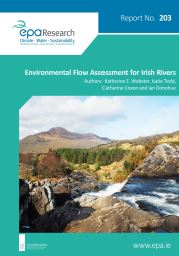Authors: Katherine E. Webster, Katie Tedd, Catherine Coxon and Ian Donohue
Summary: The overarching goal of this project was to review state of the art EFlow methodology to identify alternatives most suited to the Irish context and for developing flow standards.

Environmental flow assessment is a comprehensive approach to river management that considers multiple aspects of water flows required to protect river ecosystems and the valuable services that they provide (such as fisheries, drinking water, flood protection, etc.). Metrics of environmental flow include measurements of flow magnitude compiled at different temporal scales from daily to annual, frequency and duration of high and low flow periods, timing of events, and rates of change, all of which influence the structure and functioning of river ecosystems. River flow regime is determined by factors such as climate and catchment configuration (topography, geology, landcover) and is modified by pressures such as abstraction, catchment land use and channel modification. Thus, key first steps in applying environmental flow assessment approaches to management and policy are (1) development of a classification system that groups similar rivers by flow regime; (2) an understanding of the landscape features distinguishing groups; and (3) evaluation of the response of flow regime to current and projected abstraction pressures.
The overarching goal of this research was to evaluate state-of-the-art environmental flow methodologies to provide recommendations to the Environmental Protection Agency regarding the establishment of a landscape-based framework for setting environmental flow standards. The research used long-term (10+ year) records of daily flow from 166 river hydrometric stations to characterise five flow regime classes that differed in flow regime from flashy to stable and in landscape features such as subsurface permeability, soil drainage, precipitation and elevation. A national abstraction geodatabase was compiled to assess current abstraction pressures in relation to available water resources as measured by catchment annual effective rainfall (i.e. rainfall not evaporated or transpired) and low flow of the study rivers. Results of the study provide insights into how abstraction pressures differentially influence the flow regime of Irish rivers depending upon landscape setting and the presence of interacting pressures such as altered channel hydromorphology and land drainage.
The research identified future research needs for robust regulations such as development of ecology-flow relationships, improved understanding of flow modification as one of many interacting pressures influencing rivers, and investigation of flow regimes of under-monitored headwater streams not well-represented in our study rivers. Hydrometric monitoring data from the range of river hydrologic types found in Ireland are critical for evaluating effects of increased abstraction combined with expected climate change.
The research provides a river classification framework applicable to setting future abstraction standards for rivers in Ireland as well as for refinement of risk assessments required under the Water Framework Directive and River Basin Planning. The results highlight the difficulty in defining natural flow regime in the cultural landscape of Ireland where multiple pressures from land and channel modification, land use and abstraction interact to influence river flow. Development of an integrated national database of both abstraction and discharge with adequate temporal resolution and accurate designations of water sources was identified as a critical data need. Outputs from the research and from a stakeholder workshop provide recommendations for future research and a summary of alternative approaches to setting abstraction standards.